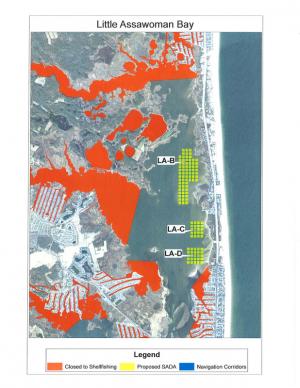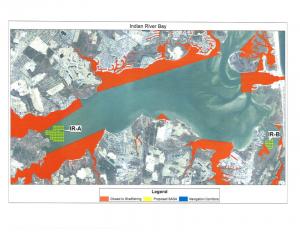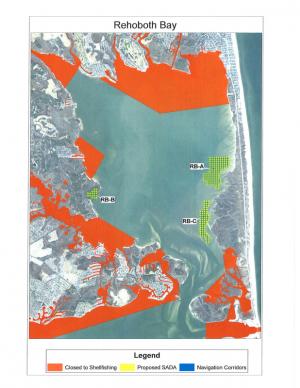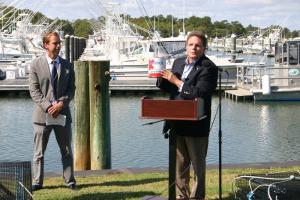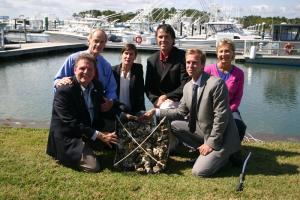Fenwick property owners protest shellfish aquaculture

The first shellfish aquaculture leases in the Inland Bays may be ready for purchase next year, but some Fenwick Island residents say it's the first they're hearing about the program.
Coastal Kayak owner Jenifer Adams-Mitchell said the new regulations allowing shellfish aquaculture in Little Assawoman Bay may raise safety concerns for some of her customers.
“For paddleboarders, if you happen to be near one of these oyster beds and you fall on it, it would be bad news,” she said. “There's a cleared spot right in front of us, but people don't stay right in front of our place; that's the beauty of what we do.”
Mitchell and a handful of Fenwick Island property owners gathered at a Sept. 18 Citizens Advisory Committee meeting at the Delaware Center for Inland Bays to oppose regulations to establish a commercial shellfish aquaculture industry in the Little Assawoman, Indian River and Rehoboth bays.
Now those property owners have joined forces as the Coalition for Sustainable Aquaculture, bringing more than a dozen bay communities together in an effort to change regulations before leases are awarded to aquaculture farmers.
The new regulations are supported by House Bill 160, signed by Gov. Jack Markell in August 2013, making Delaware the last state on the East Coast to adopt legislation establishing an aquaculture industry. They went into effect Aug. 11, but officials are awaiting the U.S. Army Corps of Engineers' approval of DNREC's application for its commercial shellfish aquaculture program.
Mitchell, who said she's known about the regulations and voiced her concerns at a public hearing in May, said she is concerned about two leasing areas, one on each side of Coastal Kayak's access to the Little Assawoman Bay.
Mitchell said the location of two of the three proposed SADAs in Little Assawoman Bay will prohibit Coastal Kayak's sailboat rentals because the boats won't have enough room to navigate if they have to come in to dock at an angle; about 15 percent of her seasonal sales come from sailboat rentals, she said.
Mitchell said safety concerns for paddleboarders, the inability to rent sailboats and possible negative aesthetic effects of the shellfish aquaculture areas will create serious economic challenges for her business.
“With Sussex County, tourism is our economy,” she said. “It seems crazy to jeopardize that.”
Aquaculture to develop over time
Eight identified areas throughout the three bays offer space for a total of 442 one-acre plots, with 209 acres in three Rehoboth Bay locations, 118 acres in three Little Assawoman Bay locations and 115 acres in two Indian River Bay locations. Each one-acre plot will be divided by 20-foot-wide channels for navigation.
“I think if 50 acres gets leased the first year, that'll be a success,” said E.J. Chalabala, who chaired the Center for the Inland Bays Tiger Team in the research phase of the proposed regulations. He added that it took 10 years for Rhode Island to expand its aquaculture industry to 150 acres.
“We're a long way away from that,” he said.
Although it's been nearly two months since the Delaware Department of Natural Resources and Environment Control finalized shellfish aquaculture regulations for the Inland Bays, some Fenwick Island residents say they had no idea what was coming.
“We must have been enjoying the bays so much that we missed all of these hearings and workshops,” said Diane Maddex, one of the coalition's founders and president of the Water's Edge Condominium Association. “In my mind, I pictured this program as a couple fisherman lowering cages into the bay, from a pier or something, nothing as extensive as it's turned out.”
Maddex said she remembers hearing about the shellfish aquaculture program a couple years ago, but she said she was unaware that it would be a commercial venture. She said she also was unaware of the meetings held by the Center for the Inland Bays Tiger Team throughout 2012 and 2013.
Process began in 2012
The research and public meeting process began in 2012 when the Center for the Inland Bays established the Tiger Team, comprising representatives from the Center for the Inland Bays, University of Delaware Sea Grant Program, Sussex County Economic Development Office, state departments and representatives with aquaculture, commercial clamming and recreational interests, according to the Center for the Inland Bays.
David Saveikis, director of the Division of Fish and Wildlife, said DNREC went beyond minimum requirements for public notice and public comment.
“I'm somewhat surprised that people are surprised about this,” Saveikis said. “We went to great lengths to ensure that public process.”
Public workshops were held earlier this year, followed by a public hearing on May 21 and a public comment period ending June 5. Maddex said she did not attend the meetings and that her contribution to the public comment process may not have made a difference.
“In retrospect, we're obviously sorry we didn't know about it. But even if we had been there, if another 50 people had made those comments, we feel DNREC would not have taken them into account,” she said.
Saveikis disagreed. “That is absolutely not true,” he said. “By law and by principal and by good governance, we consider all comments. But we consider those based on the criteria established in the law.”
Saveikis said issues like consideration of native hard clam species, navigation and public safety were the main considerations based on the proposed legislation.
Opponents: Aquaculture will destroy tranquility
Maddex and 10 fellow homeowners sent a letter to DNREC Secretary David Small Sept. 16, stating the regulations as now written will transform Little Assawoman Bay's character from one of tranquility to that of an industrial fishing operation.
They suggested changes to the regulations, including reducing the leasable area in Little Assawoman Bay, fully leasing all plots in Rehoboth and Indian River bays before starting in Little Assawoman Bay, reducing the number of markers on plots, disallowing clamming and setting reasonable business hours for the aquaculture industry.
King's Grant Condominium Association Vice President and Secretary John Neylan said a concern for property values goes alongside a concern for aesthetics.
“We right now have a beautiful bay. Is someone going to buy my house if they're looking at a forest of poles? It's really concerning,” he said.
Current regulations require corners of each one-acre plot to be marked by a PVC pole extending at least 5 feet above water at high tide.
Fenwick Island property owner John Eninger, who lives full-time in Newark but spends a majority of his weekends at the beach, said he didn't even know about the new regulations on shellfish aquaculture and proposed leasing areas until mid-September.
“I think what was lost sight of is that virtually all of the residents along Route 1 are seasonal. The meetings were held at a time when residents who would be affected just wouldn't be around,” he said. “We don't have any problem with jobs or with people making money, but there are downsides we don't think have been totally considered. …Where we go from here, I don't know.”
Federal grants support research, marking for Inland Bays aquaculture
Two federal grants announced Oct. 3 will help Delaware's shellfish aquaculture program with research and marketing needs as the state moves forward with its new regulations.
The U.S. Department of Commerce awarded $164,000 to the University of Delaware to study the economics of the program, including the water pollution protection capacity of shellfish aquaculture, the potential cost savings from using oysters to meet water quality goals and the potential to use the shellfish industry as an economic boost if consumers are willing to pay premium prices for a product that is local and marketed as improving water quality.
A second grant for $28,000 from USDA Rural Development was awarded to the University of Delaware' Sustainable Coastal Communities Initiative to work with ab+c Creative Intelligence to develop branding for Inland Bays shellfish products to be used by farmers to market products to restaurants and customers.
Center for the Inland Bays Executive Director Chris Bason said each acre of oyster aquaculture can create the potential to filter 11 to 40 million gallons of water each day.
“It really kind of hits a sweet spot because it's something that is going to provide jobs, it's going to put people to work, and those people are going to have the opportunity and the predisposition to be stewards of the bays because their success is going to be dependent upon clean water,” he said. “Like so many jobs in Sussex County, the success of our area is dependent upon clean water.”











